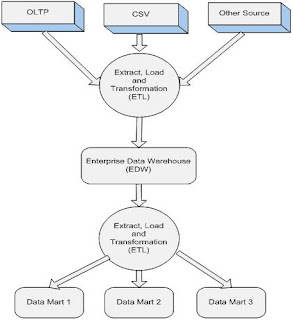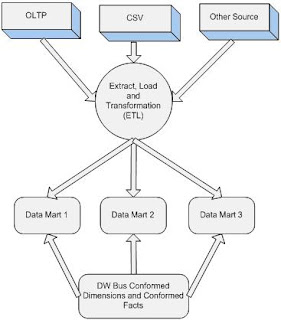In this article we will learn what is a Data warehouse? Why do we need a data warehouse? What are the characteristics of a Data warehouse? And finally go through some of the popular approaches for designing a Data warehouse.
What is Data Warehousing?
Ralph Kimball states that a data warehouse is a “Copy of transaction data specifically structured for query and analysis”
In other words; data is extracted periodically from production databases and copied onto special repository database. There it is validated, reformatted, reorganized, summarized, restructured, and merged with data from other sources. The resulted database is used to generate various summarized and ad-hoc reports, which in turn help in identifying future trends and decision making.
Why do we need a Data warehouse?
In today’s challenging times and cut-throat competition, there is a need to identify current trends, predict future trends and takes appropriate decision accordingly. Good decision can be taken only when we have all the relevant data available. Here the need of a good Data warehouse comes. A Data warehouse collects data from disparate sources and integrates them into a single source. Analysis is done using this centralized source.
Advantages and Disadvantages of a Data warehouse
Advantages:
- Large quantify of information consolidate into one location from disparate sources is available for analysis.
- Data warehouses facilitate decision support system applications such as trend reports (e.g., the items with the most sales in a particular area within the last two years), exception reports, and reports that show actual performance versus goals.
- Prior to loading data into data warehouse all data inconsistencies are identified and removed. This greatly simplifies reporting and analysis.
- Since Data warehouse is separate from operational system, they do not affect or slow down the operational system.
Disadvantages:
- Data warehouse system is complex in nature and they require skilled technical peoples and project managers.
- Setting up a Data warehouse is very expensive and time consuming.
Characteristics of a Data warehouse:
According to Bill Inmon "A warehouse is a subject-oriented, integrated, time-variant and non-volatile collection of data in support of management's decision making process"
Characteristics of a Data warehouse are explained below:
Subject-oriented: Information is present based on specific subject. Data is organized in such a way that data related to all real word elements are linked together. E.g. in operational database data will be grouped based on Loans, Savings, Demat etc. where as in warehouse data will be grouped based on subject like Customer, Vendor, Product etc.
Non-volatile: Data once entered is never updated or deleted. It is remains static and read-only for future reference.
Integrated: Data warehouse contains data from different operational data sources (OLTP) into a single integrated database.
Time Variant: Data warehouses are time variant in the sense that they maintain both historical and (nearly) current data.
Accessible: The primary purpose of a data warehouse is to provide readily available information to the en-users.
Implementation Methods
These are broadly two main approaches for designing a warehouse.
Top-down Approach

This is a Bill Inmon’s approach. In this approach data is extracted from operational system and loaded into staging area. Here the data is cleansed, consolidated and validated to ensure its accuracy and then transferred to Enterprise Data warehouse (EDW). The Data in EDW is usually in normalized form to avoid redundancy and have a detailed and true version of data. After EDW is in place, subject area specific data-marts are created which have data in de-normalized form and in a summary format.
Top-down approach should be used when:
We have complete clarity of Business requirements related to all verticals.
We are ready to invest considerable time and money.
Bottom-up Approach:

This is a Ralph Kimball’s approach. In this approach data marts are build first and then gradually the final Enterprise Data Warehouse (EDW) is build by integrating different data marts. Here separate data marts are combined based on Conformed dimensions and Conformed Facts. A Conformed dimensions and Conformed Facts can be shared across data marts.
Bottom-up approach should be used when:
We have time and money constraint.
We do not complete clarity of all verticals of Business and have clarity of only one or two business vertical.
Data warehousing Terms
Fact Table: A Fact table consists of the measurements, metrics or facts of a business process. It is often located at the centre of a star schema or a snowflake schema, surrounded by dimension tables. E.g. In a banking data warehouse accounting and balances will be stored in a Fact table.
Dimension Table: A dimension table consists of textual representation of the business process. E.g. In a banking data warehouse accounting and balances will be stored in a Fact table where as customer name, address, mobile numbers will be stored in the dimension table.
Cube: Cube is a logical schema which contains facts and dimensions
Star Schema: Star Schema is simplest data warehouse schema which consists of a few fact tables and multiple dimension tables connected to fact table.
Snowflake Schema: Snowflake schema is a variation of Star schema where dimension table are normalized into multiple related tables. Fact table remains same similar to Star schema.
Data Mart: Data marts are analytical data stores designed to focus on specific business functions for a specific community within an organization. A single Data warehouse may have multiple data marts.
Extract Transform and Load (ETL): It is a process through which data is extracted from disparate sources, transformed as per the requirement and loaded to the target database.
Operational Data Store (ODS): It comes between Staging Area and Data warehouse. Data is extracted from OLTP system to stating area and then after cleansing and validation, data is loaded into ODS. Later on data is summarized and loaded into Data warehouse.
Data Mining: Data mining (sometimes called data or knowledge discovery) is the process of analyzing data from different perspectives and summarizing it into useful information - information that can be used to increase revenue, cuts costs, or both.
Business Intelligence (BI): Business intelligence (BI) is a broad category of applications and technologies for gathering, storing, analyzing, and providing access to data to help enterprise users make better business decisions. It involves data mining, business performance management, benchmarking, text mining, and predictive analytics
Conclusion
We had learn that in Data warehousing data is collected from different sources, cleansed, validated, summarized and stored in a separate repository called data warehouse. This data is then analyzed from different perspective in order to take good business decisions.
No comments:
Post a Comment